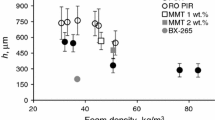Abstract
The elastic moduli of short-fiber-reinforced foams depend critically on the fiber content and fiber length, as well as on the fiber orientation distribution. Based on periodic tetrakaidecahedrons, the finite element models with short-fiber reinforcement were proposed in this paper to examine the effects of the fiber content and fiber length on Young’s modulus. The fiber length distribution and fiber orientation distribution were also considered. The proposed models featured in a three-dimensional diorama with random short-fiber distribution within or on the surfaces of the walls and edges of the closed-cells of polypropylene (PP) foams. The fiber length/orientation distributions were modeled by Gaussian probability density functions. Different fiber volume fractions, different lengths, and different distributions were investigated. The predicted Young’s moduli of the PP foams with short-glass-fiber or short-carbon-fiber reinforcement were compared with other theoretic and experimental results, and the agreement was found to be satisfactory. The proposed finite element models were proved to be acceptable to predict the Young’s moduli of the grafted closed-cell PP foams with short-fiber reinforcement.
Similar content being viewed by others
References
Clyne T W, Withers P J. An Introduction to Metal Matrix Composites. Cambridge: Cambridge University Press, 1993
Folgar F. Fiber FP/metal matrix composite connection rod: Design fabrication and performance. Ceram Eng Sci Proc, 1988, 9(7–8): 561–578
Takao Y. Thermal expansion coefficients of misoriented short-fiber reinforced composites. In: Vinson J R, Taya M, eds. Recent Advance in Composites in the United States and Japan. Hampton: ASTM STP 864, 1985. 685–699
Fu S Y, Lauke B. The elastic modulus of misaligned short-fiber reinforced polymers. Compos Sci Technol, 1988, 58(3–4): 389–400
Deng Z Y. Effect of different fiber orientations on compressive creep behavior of SiC fiber-reinforced mullite matrix composites. J Eur Ceram Soc, 1999, 19(12): 2133–2144
Weale D J, White J, Walton D. Effect of fiber orientation and distribution on the tooth stiffness of a polymer composite gear. J Reinf Plast Comp, 1999(5), 18: 454–463
Gibson R F. Principles of Composite Material Mechanics. New York: McGraw-Hill, 1994
Roberts A P, Garboczi E J. Elastic properties of model random three-dimensional open-cell solids. J Mech Phys Solids, 2002, 50(1): 33–55
Ji S. Generalized means as an approach for predicting Young’s moduli of multiphase materials. Mat Sci Eng A-Structure, 2004, 366(1): 195–201
Li K, Gao X L, Roy A K. Micromechanics model for three-dimensional open-cell foams using a tetrakaidecahedral unit cell and Castigliano’s second theorem. Compos Sci Technol, 2003, 63(12): 1769–1781
Dement’ev A G, Tarakanov O G. Effect of cellular structure on the mechanical properties of plastic foams. Polym Mech, 1970, 6(4): 519–25
Zhu H X, Knott J F, Mills N J. An analysis of the elastic properties of open-cell foams with tetrakaidecahedral cells. J Mech Phys Solids, 1997, 45(3): 319–343
Van der Burg M W D, Shulmeister V, Van der Geissen E, et al. On the linear elastic properties of regular and random open-cell foams models. J Cell Plast, 1997, 33(1): 31–54
Harn F E, Han F Y, Liao L Q. Young’s moduli prediction of polypropylene foams using finite element method. In: Proc 51st Int SAMPE Symposium and Exhibition. Long Beach: SAMPE, 2006. 2346–2355
Yurgartis S W. Measurement of small angle fiber misalignments in continuous fiber composites. Compos Sci Technol, 1987, 30(4): 279–293
Lauke B, Fu S Y. Strength anisotropy of misaligned short- fiber-reinforced polymers. Compos Sci Technol, 1999, 59(5): 699–708
Jayaraman K, Kortschot M T. Correction to the Fukuda-kawata Young’s modulus and the Fukuda Chou strength theory for short fiber-reinforced composite materials. J Mater Sci, 1996, 31(8): 2059–2064
Throne J L. Thermoplastic Foams. Ohio: Sherwood Publishers, 1996
Thomason J L, Vlug M A. Influence of fiber length and concentration on the properties of glass fiber reinforced polypropylene: 1. Tensile and flexural modulus. Compos Part A-Appl S, 1996, 27(6): 477–484
Author information
Authors and Affiliations
Corresponding author
Additional information
Supported by the National Natural Science Foundation of China (Grant No. 50573095)
Rights and permissions
About this article
Cite this article
Wang, B., Wang, R. & Wu, Y. The Young’s moduli prediction of random distributed short-fiber-reinforced polypropylene foams using finite element method. Sci. China Ser. E-Technol. Sci. 52, 72–78 (2009). https://doi.org/10.1007/s11431-008-0282-7
Received:
Accepted:
Published:
Issue Date:
DOI: https://doi.org/10.1007/s11431-008-0282-7




